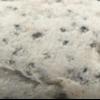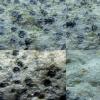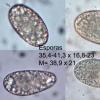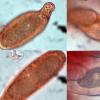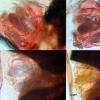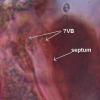
08-11-2025 00:29
 Francois Guay
Francois Guay
I found this species in Quebec, Canada, on herbace

04-11-2025 09:07
Hello.A suspected Hymenoscyphus sprouting on a thi

04-11-2025 12:43
 Edvin Johannesen
Edvin Johannesen
Hi! One more found on old Populus tremula log in O

03-11-2025 21:34
 Edvin Johannesen
Edvin Johannesen
These tiny (0.4-0.5 mm diam.), whitish, short-stip
En los tallos viejos del hinojo silvestre (Foeniculum vulgare)
Castillo Joseba,
27-01-2020 15:32
No tengo idea de por donde mirar
A ver si hay alguna sugerencia
Saludos
Joseba
Hans-Otto Baral,
27-01-2020 16:00

Re : En los tallos viejos del hinojo silvestre (Foeniculum vulgare)
This looks like a very interesting fungus, but I have no idea. Do you have a closeup photo of the living paraphyses?
The 2-spores asci reminded me of Didymascella on Thuja, but there the spores have an eccentrial septum.
Is the apothecium closed by a covering layer that splits into teeth and opens when hydrated for some minutes?
Castillo Joseba,
27-01-2020 16:04
Re : En los tallos viejos del hinojo silvestre (Foeniculum vulgare)
Hola Zotto
No me doy cuenta de haber visto parafisis... tendré que mirar mejor
Si son como discos y al ponerlos el agua en el porta al rato comienzan a abrirse y se ven salir las esporas
Seguiré mirando
Joseba
No me doy cuenta de haber visto parafisis... tendré que mirar mejor
Si son como discos y al ponerlos el agua en el porta al rato comienzan a abrirse y se ven salir las esporas
Seguiré mirando
Joseba
Hans-Otto Baral,
27-01-2020 16:22

Re : En los tallos viejos del hinojo silvestre (Foeniculum vulgare)
But your macros are in dry state??
On your last photo I think I see paraphyses.
Castillo Joseba,
27-01-2020 16:30
Re : En los tallos viejos del hinojo silvestre (Foeniculum vulgare)
El material es seco y lo rehidrato sobre el porta, la parte que voy a usar
No soy capaz de ver parafisis en estas fotos.... supongo que si los hay no se cual son
No soy capaz de ver parafisis en estas fotos.... supongo que si los hay no se cual son
Hans-Otto Baral,
27-01-2020 17:11

Re : En los tallos viejos del hinojo silvestre (Foeniculum vulgare)
Can you send me the last collage by Email?
It would important to make a macrophoto of a fully hydrated apo at maximum possible magnification. I know this is difficult, the water disturbs and one has to find the exact time when it is still wet but only internally.
Hans-Otto Baral,
27-01-2020 17:24
Castillo Joseba,
27-01-2020 17:34
Antonio Gómez-Bolea,
27-01-2020 19:16
Re : En los tallos viejos del hinojo silvestre (Foeniculum vulgare)
Hola,
Se trata de Leveillula lanuginosa
Se trata de Leveillula lanuginosa
Castillo Joseba,
27-01-2020 19:31
Re : En los tallos viejos del hinojo silvestre (Foeniculum vulgare)
Muchas gracias Antonio
Hans-Otto Baral,
27-01-2020 20:24

Re : En los tallos viejos del hinojo silvestre (Foeniculum vulgare)
Oh, this is reasonable! The species was also treated here:
I conclude the apothecoid ascomata are collapsed cleistothecia, collapsed because dry.
Anyway I wonder what these paraphyses are that I saw. And what kind of content they have.
Since Erysiphales are considered related with Helotiales in the Leotiomycetes, I wonder about paraphyses.
What this abundant white felt might be? Seems then to belong to the fungus.



